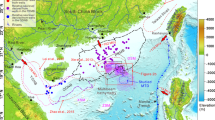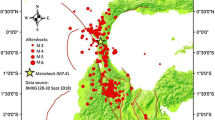Abstract
In this paper, we investigate the sources for Palu Bay tsunamis, which occurred in September 2018 after a Mw 7.5 earthquake struck on a strike-slip fault. Previous land-based field studies have identified numerous coastal landslides as possible sources for tsunami generation. Here, we present new post-earthquake bathymetry survey data in the bay. We compare the new very detailed nearshore bathymetry with the pre-earthquake data so as to quantify the magnitudes and configurations of coastal landslides and the characteristics of landslide-generated waves. We perform numerical simulations of tsunami propagation, isolating the coastal landslides as the only sources. The results show that, although the landslide-generated waves characteristically have shorter periods than the observed tsunami waves, the combination of the waves is able to produce long waves comparable with those observed, due to the ringing effects of the trapped waves inside the bay. Therefore, we conclude that landslide-generated waves played a significant role in the tsunamis in Palu Bay. Nevertheless, it is likely that the tsunamis were caused by a combination of tectonic and landslide sources.






Similar content being viewed by others
Data availability
BIG bathymetry data is publicly available on the internet (National Mapping Agency of Indonesia 2019). The datasets generated and analyzed in the current study are available from the corresponding authors on reasonable request.
References
An C, Sepúlveda I, Liu PL-F (2014) Tsunami source and its validation of the 2014 Iquique, Chile earthquake. Geophys Res Lett 41:3988–3994. https://doi.org/10.1002/2014GL060567
Arikawa T, Muhari A, Okumura Y, Dohi Y, Afriyanto B, Sujatmiko KA, Imamura F (2018) Coastal subsidence induced several tsunamis during the 2018 Sulawesi earthquake. J Dis Res 13:sc20181204. https://doi.org/10.20965/jdr.2018
Carvajal M, Araya-Cornejo C, Sepúlveda I, Melnick D, Haase JS (2019) Nearly-instantaneous tsunamis following the Mw 7.5 2018 Palu earthquake. Geophys Res Lett 46(10):5117–5126. https://doi.org/10.1029/2019GL082578
Frederik MCG, Udrekh, Adhitama R, Hananto ND, Asrafil, Sahabuddin S, Irfan M, Moefti O, Putra DB, Riyalda BF (2019) First results of a bathymetric survey of Palu Bay, Central Sulawesi, Indonesia following the tsunamigenic earthquake of 28 September 2018. Pure Appl Geophys 176(8):3277–3290. https://doi.org/10.1007/s00024-019-02280-7
Fritz, H.M., Synolakis, C., Kalligeris, N., Skanavis, V., Mohammad Rizal, F.S., Prasetya, G.S. & Liu, P.L.-F. (2018) Field survey of the 28 September 2018 Sulawesi tsunami. American Geophysical Union Fall Meeting 2018, Abstract #NH22B-04
Garzon J, Ferreira C (2016) Storm surge modeling in large estuaries: sensitivity analyses to parameters and physical processes in the Chesapeake Bay. J Mar Sci Eng 4(3):45. https://doi.org/10.3390/jmse4030045
Glimsdal S, Pedersen GK, Harbitz CB, Løvholt F (2013) Dispersion of tsunamis: does it really matter? Nat Hazards Earth Syst Sci 13:1507–1526. https://doi.org/10.5194/nhess-13-1507-2013
Goda K, Mori N, Yasuda T, Prasetyo A, Muhammad A, Tsujio D (2019) Cascading geological hazards and risks of the 2018 Sulawesi Indonesia earthquake and sensitivity analysis of tsunami inundation simulations. Front Earth Sci 7:261. https://doi.org/10.3389/feart.2019.00261
Grilli ST, Watts P (2005) Tsunami generation by submarine mass failure. Part I: modeling, experimental validation, and sensitivity analysis. J Waterw Port Coast Ocean Eng 131:283–297. https://doi.org/10.1061/(ASCE)0733-950X(2005)131:6(283
Heidarzadeh, M., Krastel, S., & Yalciner, A. C. (2014). The state-of-the-art numerical tools for modeling landslide tsunamis: a short review. Submarine Mass Movements and Their Consequences. Advances in natural and technological hazards research, vol 37. Springer, Cham. https://doi.org/10.1007/978-3-319-00972-8_43
Heidarzadeh M, Muhari A, Wijanarto AB (2019) Insights on the source of the 28 September 2018 Sulawesi tsunami, Indonesia based on spectral analyses and numerical simulations. Pure Appl Geophys 176(1):25–42. https://doi.org/10.1007/s00024-018-2065-9
Iglesias O, Lastras G, Canals M, Olabarrieta M, Gonzalez M, Aniel-Quiroga Í, Otero L, Durán R, Amblas D, Casamor JL, Tahchi E, Tinti S, De Mol B (2012) The BIG’95 submarine landslide–generated tsunami: a numerical simulation. J Geol 120(1):31–48. https://doi.org/10.1086/662718
Jamelot A, Gailler A, Heinrich P, Vallage A, Champenois P (2019) Tsunami simulations of the Sulawesi Mw 7.5 event: comparison of seismic sources issued from a tsunami warning context versus post-event finite source. Pure Appl Geophys 176(8):3351–3376. https://doi.org/10.1007/s00024-019-02274-5
Jones, M. (2016). What caused the 1959 Hebgen Lake seiche?: an investigation incorporating 1959 tide gauge data, newly acquired chirp seismic data and numerical wave modeling. Master Thesis, Southern Methodist University
Liu, P.L.-F., Woo, S.-B. & Cho, Y.-S. (1998) Computer programs for tsunami propagation and inundation. Technical report, Cornell University
Liu, P.L.-F., Barranco, I., Fritz, H., Haase, J.S., Prasetya, G.S., Qiu, Q., Sepúlveda, I., Synolakis, C. & Xu, X. (2018) What we do and don’t know about the 2018 Palu tsunami–a future plan. American Geophysical Union Fall Meeting 2018, Abstract #NH23F-3551
Lo, H.Y. (2018) Modeling landslide-generated tsunamis with long-wave equations, PhD thesis, Cornell University
Lo HY, Liu PL-F (2017) On the analytical solutions for water waves generated by a prescribed landslide. J Fluid Mech 821:85–116. https://doi.org/10.1017/jfm.2017.251
Mikami T, Shibayama T, Esteban M, Takabatake T, Nakamura R, Nishida Y, Achiari H, Rusli, Marzuki AG, Marzuki MFH, Stolle J, Krautwald C, Robertson I, Aránguiz R, Ohira K (2019) Field survey of the 2018 Sulawesi tsunami: inundation and run-up heights and damage to coastal communities. Pure Appl Geophys 176(8):3291–3304. https://doi.org/10.1007/s00024-019-02258-5
Muhari A, Imamura F, Arikawa T, Hakim AR, Afriyanto B (2018) Solving the puzzle of the September 2018 Palu, Indonesia tsunami mystery: clues from the tsunami waveform and the initial field survey data. J Dis Res 13, (Scientific Communication). https://doi.org/10.20965/jdr.2018.sc20181108
National Mapping Agency of Indonesia (2019). Palu bathymetries. Retrieved from: https://portal.ina-sdi.or.id/arcgis/rest/services/LPI/PALU_DONGGALA/MapServer . Last accessed 10 August 2019
Omira R, Dogan GG, Hidayat R, Husrin S, Prasetya GS, Annunziato A, Proietti C, Probst P, Paparo MA, Wronna M, Zaytsev A, Pronin P, Giniyatullin A, Putra PS, Hartanto D, Ginanjar G, Kongko W, Pelinovsky E, Yalciner AC (2019) The September 28th, 2018, tsunami in Palu-Sulawesi, Indonesia: a post-event field survey. Pure Appl Geophys 176(4):1379–1395. https://doi.org/10.1007/s00024-019-02145-z
Pakoksung K, Suppasri A, Imamura F, Athanasius C, Omang A, Muhari A (2019) Simulation of the submarine landslide tsunami on 28 September 2018 in Palu Bay, Sulawesi Island, Indonesia, using a two-layer model. Pure Appl Geophys 176(8):3323–3350. https://doi.org/10.1007/s00024-019-02235-y
Sassa S, Takagawa T (2019) Liquefied gravity flow-induced tsunami: first evidence and comparison from the 2018 Indonesia Sulawesi earthquake and tsunami disasters. Landslides 16:195–200. https://doi.org/10.1007/s10346-018-1114-x
Takagi H, Pratama MB, Kurobe S, Esteban M, Aránguiz R, Ke B (2019) Analysis of generation and arrival time of landslide tsunami to Palu City due to the 2018 Sulawesi earthquake. Landslides 16(5):983–991. https://doi.org/10.1007/s10346-019-01166-y
Ulrich T, Vater S, Madden EH, Behrens J, van Dinther Y, van Zelst I, Fielding EJ, Liang C, Gabriel A-A (2019) Coupled, physics-based modeling reveals earthquake displacements are critical to the 2018 Palu, Sulawesi tsunami. Pure Appl Geophys 176(10):4069–4109. https://doi.org/10.1007/s00024-019-02290-5
USGS (2018). Technical report. Retrieved from: https://earthquake.usgs.gov/earthquakes/eventpage/us1000h3p4/executive . Last accessed 10 August 2019
Valkaniotis, S., Ganas, A., Tsironi, V. & Barberopoulou, A. (2018) A preliminary report on the M7.5 Palu earthquake co-seismic ruptures and landslides using image correlation techniques on optical satellite data. Technical report. https://doi.org/10.5281/zenodo.1467128
Wang X (2009) User manual for COMCOT version 1.7. Institute of Geological & Nuclear Science, New Zealand
Watts P, Grilli ST, Tappin D, Fryer GJ (2005) Tsunami generation by submarine mass failure. Part II: predictive equations and case studies. J Waterw Port Coast Ocean Eng 131:298–310. https://doi.org/10.1061/(ASCE)0733-950X(2005)131:6(298)
Wilson BW (1972) Seiches. In: Advances in hydroscience, vol 8. Elsevier, pp 1–94. https://doi.org/10.1016/B978-0-12-021808-0.50006-1
Yavari-Ramshe S, Ataie-Ashtiani B (2016) Numerical modeling of subaerial and submarine landslide-generated tsunami waves-recent advances and future challenges. Landslides 13(6):1325–1368. https://doi.org/10.1007/s10346-016-0734-2
Acknowledgments
We would like to thank the Marine Research Centre of the Ministry of Marine Affairs and Fisheries of Indonesia (MMAF) Indonesia, the Indonesian Tsunami Society (IATsI), and the Ministry of Research, Technology and Higher Education of Indonesia (MORTHE) for making the nearshore survey possible. We also would like to acknowledge the cooperation with the Hydrography and Oceanography Center (PUSHIDROSAL) of the Indonesian Navy and its head, Rear Admiral Harjo Susmoro, for sharing the deep water survey data. Supports from Bpk. Abdul Rasyid from the Fisheries Port of Donggala, Capt. Oke Dwiyana P from PUSHIDROSAL, Dr. Widjo Kongko from BPPT, Mr. Ardito Kodijat from IOTIC IOC/UNESCO, and Dr. Rahman Hidayat from the Coordinating Ministry of Maritime Affairs of Indonesia (Kemenkomaritim) are also highly appreciated. We would like to thank PT. GEOTINDO, Mr. Ignacio Barranco, Dr. Kuifeng Zhao, and the crew of fishermen from boat PACEKO for the acquisition of the data in the field. We would also like to thank Dr. Hong-Yueh Lo for valuable discussions about his landslide-induced wave generation model and Dr. Ignacio Sepúlveda and Mr. Yu-Lin Tsai for their support with the COMCOT model. This paper contains satellite imagery from Google Earth, Digital Globe open data for disaster response, and Sentinel-2 cloudless data (https://s2maps.eu by EOX IT Services GmbH; containing modified Copernicus Sentinel data 2017 and 2018).
Funding
The authors acknowledge internal funding from the National University of Singapore.
Author information
Authors and Affiliations
Contributions
P.L.-F. Liu acquired the funding and coordinated the project. P.L.-F. Liu, P. Higuera, S. Husrin, and G.S. Prasetya conceptualized the work. P. Higuera, J. Prihantono, H. Diastomo, and D.G. Pryambodo performed the field survey and carried out the raw data analysis. H. Susmoro provided the deep water survey data. P. Higuera performed the data analysis and simulations and prepared the visualizations. P.L.-F. Liu and P. Higuera prepared the original draft. All authors contributed to reviewing and editing the final paper.
Corresponding authors
Ethics declarations
The authors comply with ethical standards.
Competing interests
The authors declare that they have no competing interests.
Electronic supplementary material
ESM 1
(DOCX 1.87 mb)
Rights and permissions
About this article
Cite this article
Liu, P.LF., Higuera, P., Husrin, S. et al. Coastal landslides in Palu Bay during 2018 Sulawesi earthquake and tsunami. Landslides 17, 2085–2098 (2020). https://doi.org/10.1007/s10346-020-01417-3
Received:
Accepted:
Published:
Issue Date:
DOI: https://doi.org/10.1007/s10346-020-01417-3




